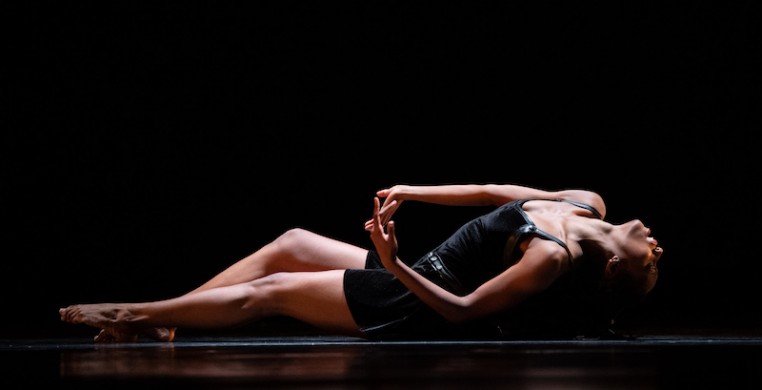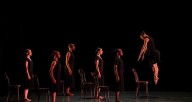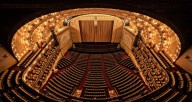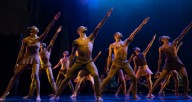Deeply Rooted Dance Theater (DRDT) concluded its 25th anniversary season at the Auditorium Theatre Oct. 23 with “Roots & Wings,” a one-night only program of viscerally transformative dance and dance theater works. The momentous show ignited the space between tradition and innovation, featuring classic repertory pieces by co-founders Gary Abbott and Kevin Iega Jeff, a company premiere of Ulysses Dove’s “Episodes,” and a preview of DRDT’s latest interdisciplinary collaboration, “Goshen.”
A near-packed house of (vaccinated and masked) people came together to witness the profoundly moving, edge-of-your-seat, near-nonstop-applause, shout-out-when-you-feel-compelled-to, what-are-you-still-doing-sitting-down-get-up-and-join-us-you-are-part-of-this-performance-too kind of live, in-person dancing that only Deeply Rooted can deliver. DRDT’s presentation of “Roots & Wings” was part of the Auditorium’s “Made in Chicago” Dance Series and marked DRDT’s triumphant return to evening-length performance.
Abbott’s “Bach’d” (2011) opened the show with a nuanced physical and sonic sensitivity that set the tone for the remainder of the night. Airy, suspended cartwheels were accentuated by fluttering hands and dizzyingly tight turns, all perfectly attuned to the melodic engine and expressive trills active in the musical composition. A horizontal line of dancers spanning the width of the stage softened their stances one-by-one in a ripple of audible exhales, embodying a decrescendo in the music and flirting with an ending, just before revving back up into an encore of brilliantly vibrant movement. I sensed the entire theater sit up taller in this moment, re-activated and ready for more. Make no mistake—DRDT was just getting started.
Jeff’s “Gula Matari” (1984) followed suit, guiding us into a new world completely. Quincy Jones’ music beckoned the curtain back up, revealing Joshua L. Ishmon, Alyssa McCallum, Joshua Francique, Saidiya Imari, Ruddy A. Frias and Taylor Ramos seated in close proximity at center stage. The shared posture of a slightly curved spine, downward focus, hovering over their legs appeared restful but alert. An alluring haze seeped in from the wings, dramatizing the robust beams of six strategically hung overhead lights.
Without lifting their eyes, the dancers synchronously brushed the backs of their hands across the floor in front of them, gently unfurled their fingertips and modestly bent their spines. The subtlety of these movements flowed effortlessly into loud moments of impressive partnering. Notably, McCallum, Imari and Ramos stood on the shoulders of Ishmon, Francique and Frias—the three towering couples rotating around themselves in tight, quick orbits. The dancers continued to breathe liquid expressivity and explosive power, strategically tapped by Jeff, into exquisite technical feats drenched in visible musicality.
After “Gula Matari,” the beginning duet of Ulysses Dove’s “Episodes” exploded out of the wings. Ready or not, dancers Joshua Lamar Henry and Francique came flying onto the stage in lofty, gravity-defying jumps. The pair turned endlessly in harmonious rhythm and identical depth of plié—an undertaking made even more impressive by the continuation of the momentum into and out of the floor in high-stakes knee spins and hinges that never once wavered in velocity or virtuosity. Their extraordinary technical prowess was matched, challenged even, when Frias and Isaiah Harvey repeated the duet choreography later in the work.
Sarah Lackner’s additions to John B. Reade’s original lighting design maintained the signature diagonal pathways of light surrounded by near-complete darkness in “Episodes.” The illuminated channels of light eventually intersected into an “X” formation, intensifying the passionately charged episodes of overlapping human relationship(s) that cycled across the stage. The likes of which ranged from forceful to playful to competitive to pleasurable to empowering to longing to abandoned to fulfilled, and more.
It is challenging to put into words the fervor and raw power that DRDT brought to Dove’s work. Particularly, Francique and Emani Drake’s fiery duet that upped the dramatic ante to palpable levels. Facing one another, standing center stage with eyes locked, the pair paused, magnetizing the air in a captivating physical silence. Francique held his hands on either side of Drake’s hips and started a slow descent. I was so transfixed by their shared gaze that it took me a second (or two… maybe three) to realize that Francique was lowering into a prolonged center split. Drake held firm in her stance and maintained Francique’s eyes, lowering her chin in time with his descent, creating a dynamic shift of levels as well as power.
After a brief intermission of collective awe, DRDT artistic director Nicole Clarke-Springer and Grammy Award-winning producer, composer and gospel artist Donald Lawrence took to the stage to introduce Act Two, a preview of “Goshen” originally scheduled to take place at Millennium Park in August. (The show was canceled due to inclement weather.)
Everything about “Goshen” exuded abundance. The dance-theater work straddled a broad array of musical influences—from gospel to R&B to jazz to blues to rock—highlighting Lawrence’s musical theater background and directorial range. Several dance languages were also put into harmonious conversation; “Goshen” has it all, skillfully diversifying the aesthetics of contemporary dance while rooting them in American and African diasporic dance traditions.
“My Revival,” with choreography by Jeff and lead vocals from LeJuene Thompson, was particularly compelling. Thompson drew me in with her spoken text that grew in warmth and volume, ushering in the song’s tranquil melody and a breathtakingly smooth canon of dancers falling over the tops of their toes in a successive, slow-motion cascade to the floor. The dancers continued to stretch time, alternating an extension of the arm out to the audience as they crawled forward; grasping and pulling, with rigor, at the heartstrings that connect performer and spectator—bridging the literal and metaphorical space between them.
Simply put, “Gosehen” is not to be performed by the faint-hearted. It is not even a work to be performed. Rather, it is one that has to be lived. And the powerhouse of interdisciplinary performers in the work did just that, adding refreshingly contemporary interpretations of historic biblical themes of oppression and liberation while commanding every inch of the stage with a world-shaking power and graceful finesse that was beyond musical. It was spiritual.
“Roots & Wings” provided DRDT an opportunity to both ground itself and take flight at the intersection of promise and purpose. The 25th anniversary season finale performance reaffirmed that DRDT is here to stay—proving definitively that DRDT wasn’t just “made in Chicago,” but makes Chicago and will continue shaping the creative landscape and greater heart of this city (and beyond) for lifetimes to come.




